Students’ autonomy in english learning at Thai Nguyen university of technology
This paper presents a study on investigating the learner autonomy of the first-year non-English
major students in English learning at Thai Nguyen University of Technology. The results report
that student’s autonomy in English learning is not quite positive. It is suggested that more attention
should be paid to learner autonomy during learning and teaching process at the university. In
addition, some implications to encourage learner autonomy are suggested.
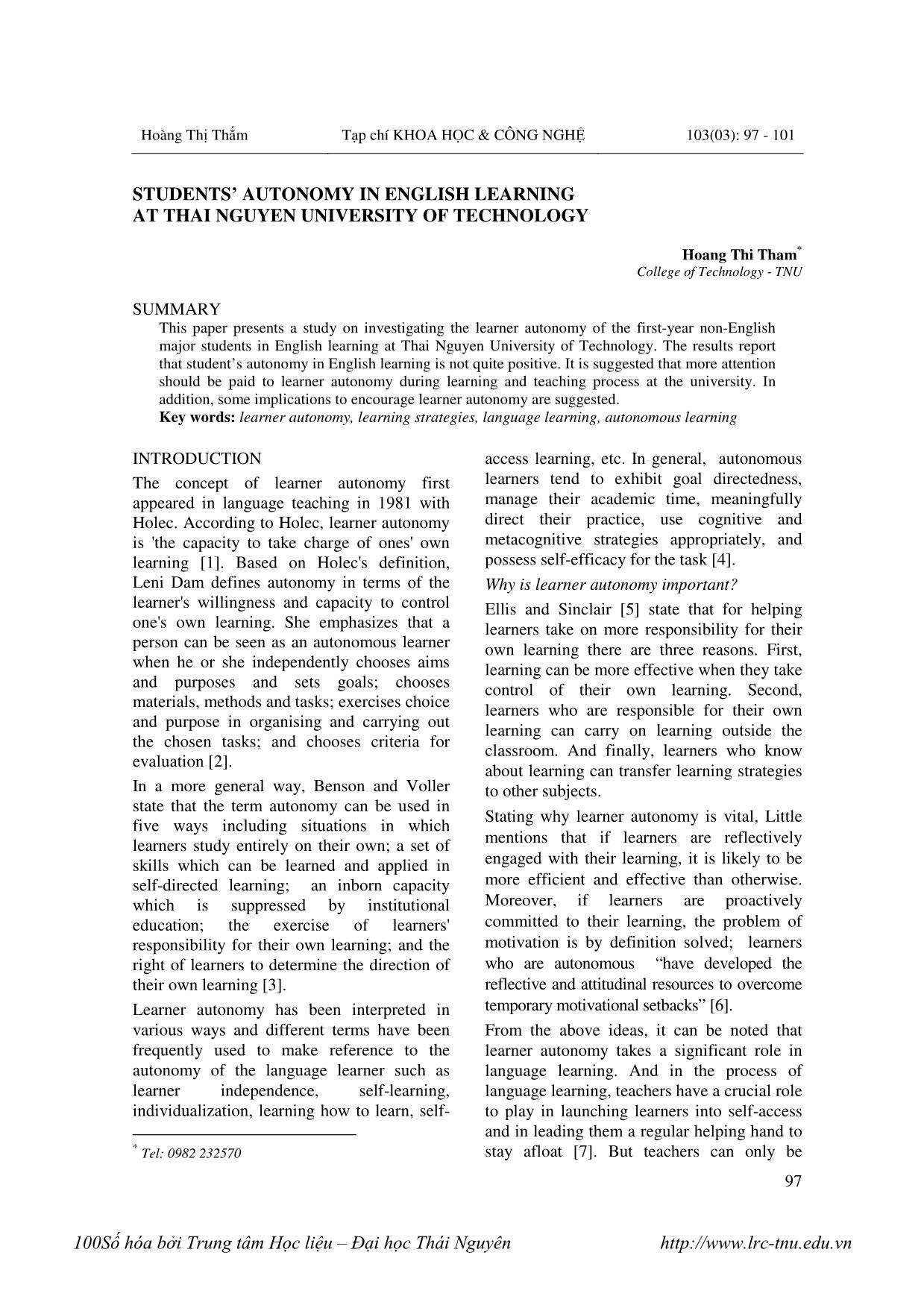
Trang 1
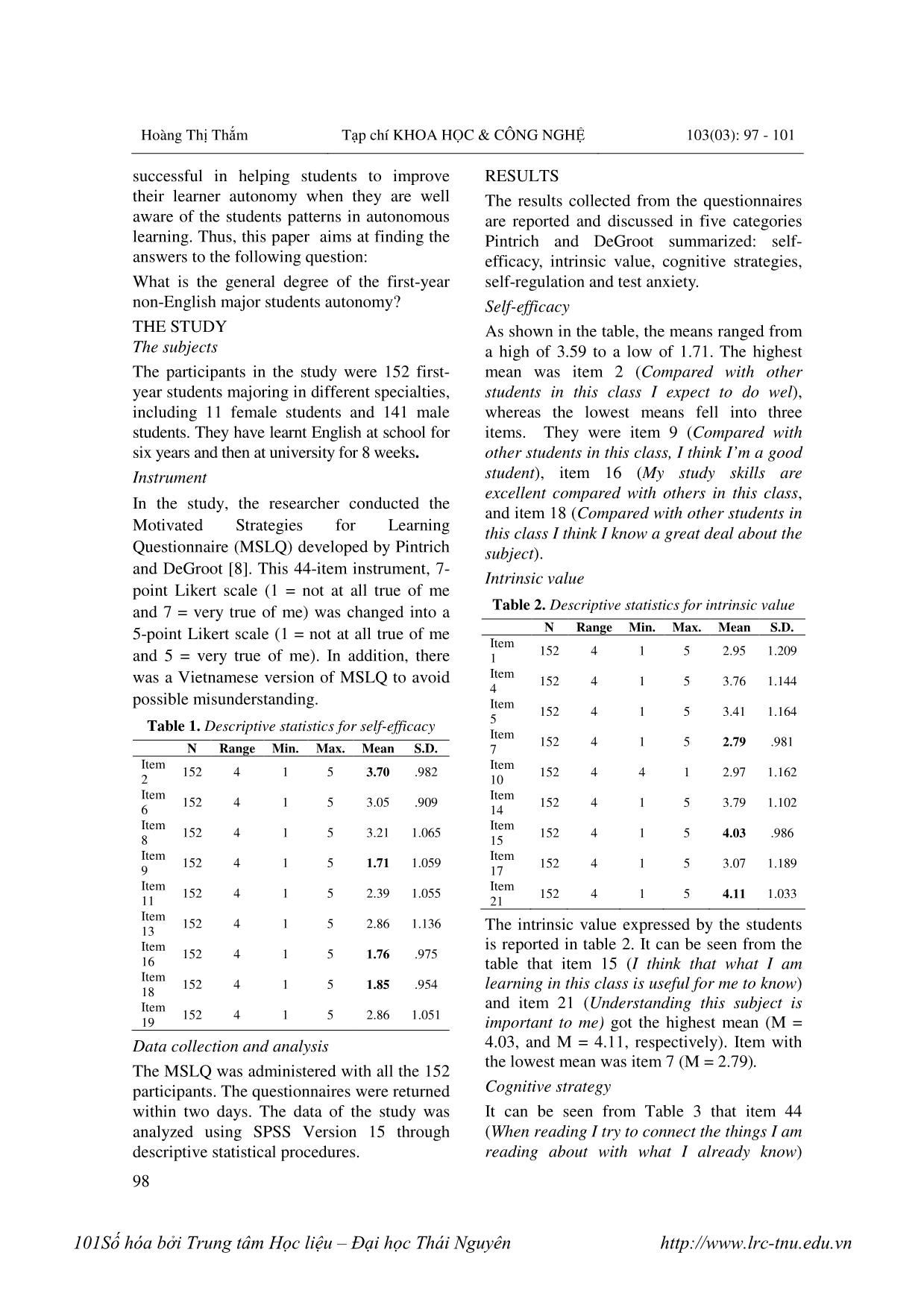
Trang 2
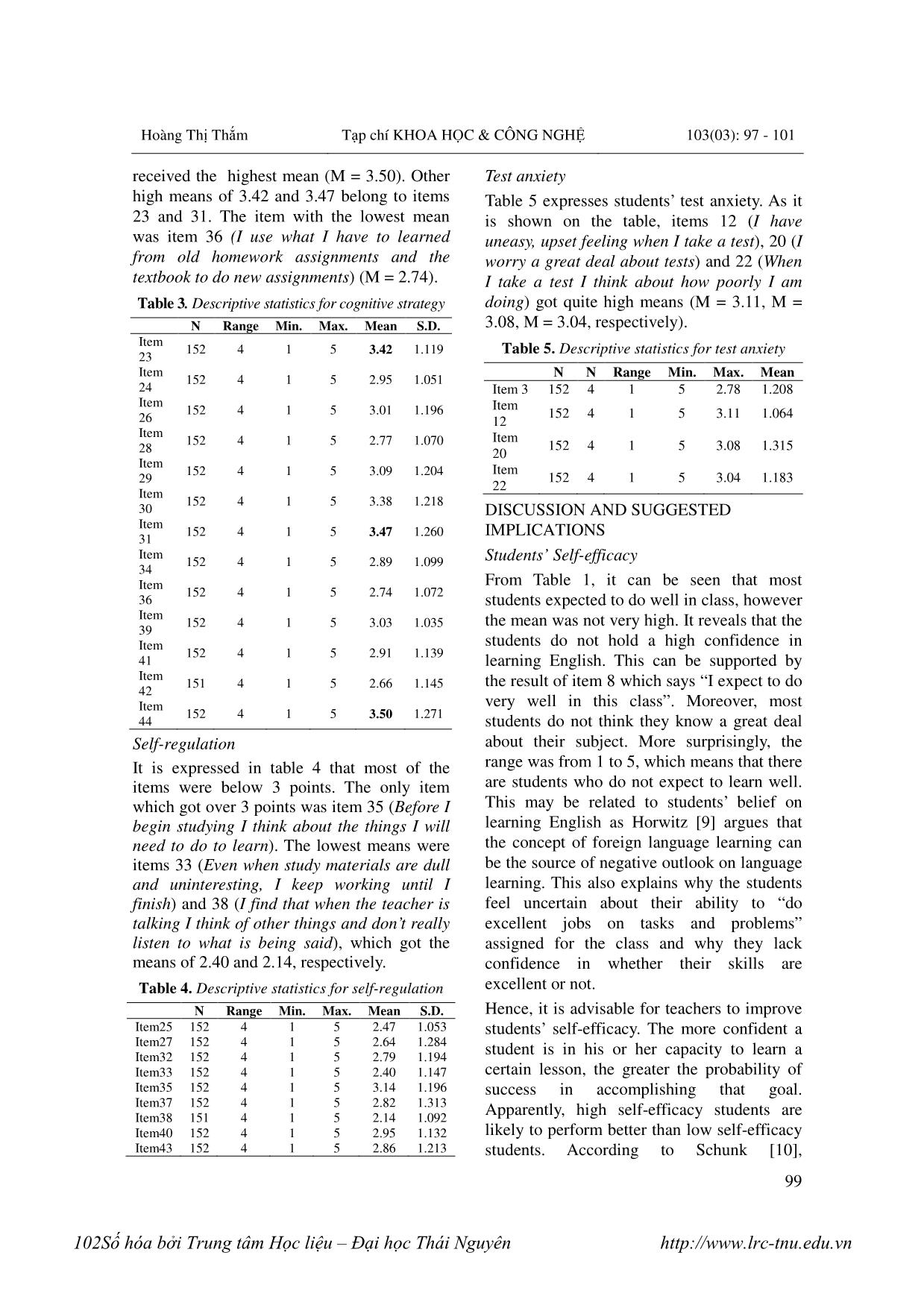
Trang 3

Trang 4
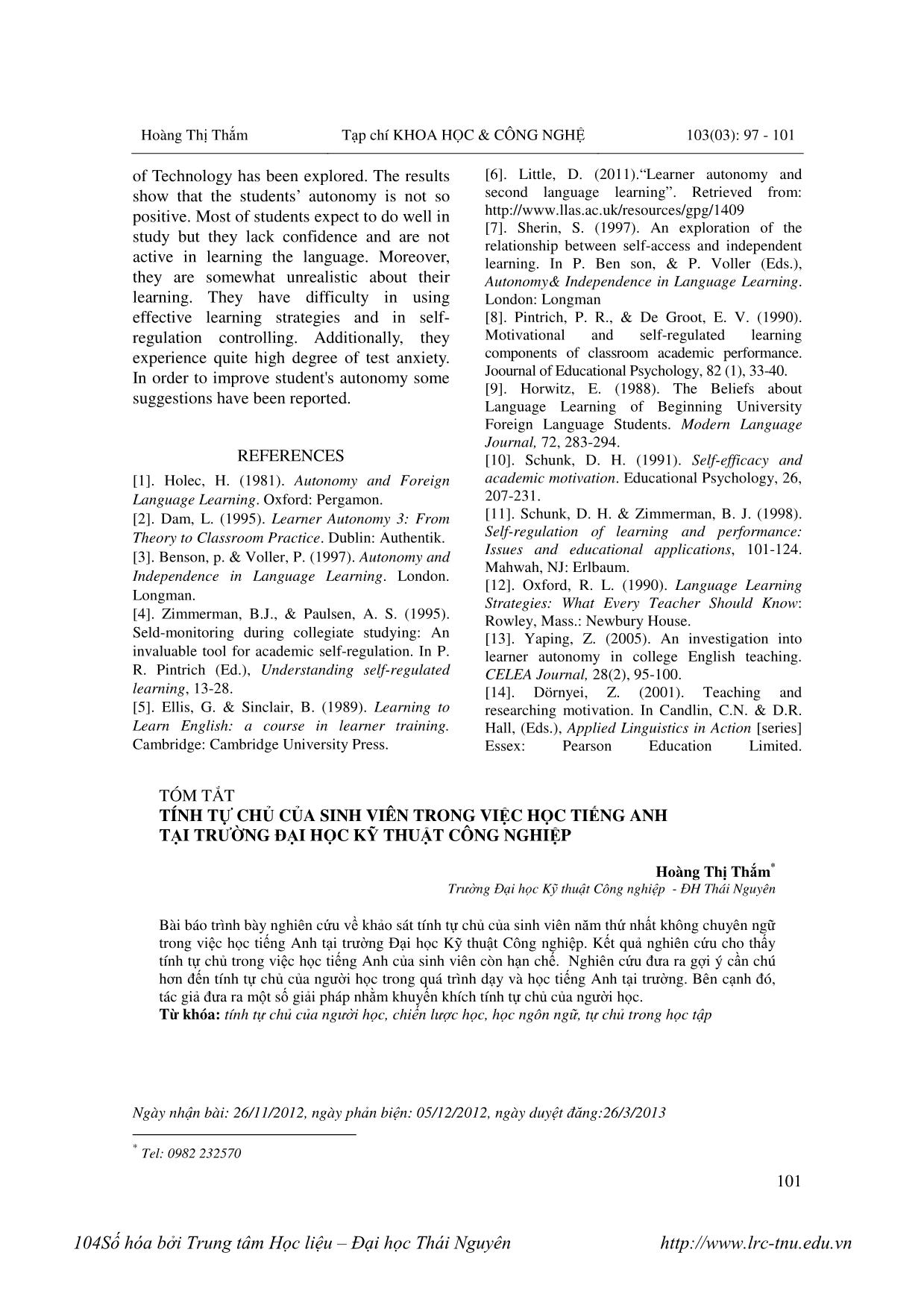
Trang 5
Bạn đang xem tài liệu "Students’ autonomy in english learning at Thai Nguyen university of technology", để tải tài liệu gốc về máy hãy click vào nút Download ở trên
Tóm tắt nội dung tài liệu: Students’ autonomy in english learning at Thai Nguyen university of technology
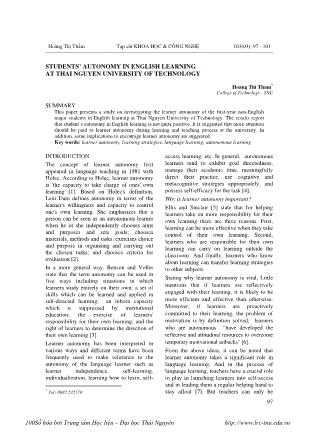
Hoàng Thị Thắm Tạp chí KHOA HỌC & CÔNG NGHỆ 103(03): 97 - 101 97 STUDENTS’ AUTONOMY IN ENGLISH LEARNING AT THAI NGUYEN UNIVERSITY OF TECHNOLOGY Hoang Thi Tham* College of Technology - TNU SUMMARY This paper presents a study on investigating the learner autonomy of the first-year non-English major students in English learning at Thai Nguyen University of Technology. The results report that student’s autonomy in English learning is not quite positive. It is suggested that more attention should be paid to learner autonomy during learning and teaching process at the university. In addition, some implications to encourage learner autonomy are suggested. Key words: learner autonomy, learning strategies, language learning, autonomous learning INTRODUCTION* The concept of learner autonomy first appeared in language teaching in 1981 with Holec. According to Holec, learner autonomy is 'the capacity to take charge of ones' own learning [1]. Based on Holec's definition, Leni Dam defines autonomy in terms of the learner's willingness and capacity to control one's own learning. She emphasizes that a person can be seen as an autonomous learner when he or she independently chooses aims and purposes and sets goals; chooses materials, methods and tasks; exercises choice and purpose in organising and carrying out the chosen tasks; and chooses criteria for evaluation [2]. In a more general way, Benson and Voller state that the term autonomy can be used in five ways including situations in which learners study entirely on their own; a set of skills which can be learned and applied in self-directed learning; an inborn capacity which is suppressed by institutional education; the exercise of learners' responsibility for their own learning; and the right of learners to determine the direction of their own learning [3]. Learner autonomy has been interpreted in various ways and different terms have been frequently used to make reference to the autonomy of the language learner such as learner independence, self-learning, individualization, learning how to learn, self- * Tel: 0982 232570 access learning, etc. In general, autonomous learners tend to exhibit goal directedness, manage their academic time, meaningfully direct their practice, use cognitive and metacognitive strategies appropriately, and possess self-efficacy for the task [4]. Why is learner autonomy important? Ellis and Sinclair [5] state that for helping learners take on more responsibility for their own learning there are three reasons. First, learning can be more effective when they take control of their own learning. Second, learners who are responsible for their own learning can carry on learning outside the classroom. And finally, learners who know about learning can transfer learning strategies to other subjects. Stating why learner autonomy is vital, Little mentions that if learners are reflectively engaged with their learning, it is likely to be more efficient and effective than otherwise. Moreover, if learners are proactively committed to their learning, the problem of motivation is by definition solved; learners who are autonomous “have developed the reflective and attitudinal resources to overcome temporary motivational setbacks” [6]. From the above ideas, it can be noted that learner autonomy takes a significant role in language learning. And in the process of language learning, teachers have a crucial role to play in launching learners into self-access and in leading them a regular helping hand to stay afloat [7]. But teachers can only be 100Số hóa bởi Trung tâm Học liệu – Đại học Thái Nguyên Hoàng Thị Thắm Tạp chí KHOA HỌC & CÔNG NGHỆ 103(03): 97 - 101 98 successful in helping students to improve their learner autonomy when they are well aware of the students patterns in autonomous learning. Thus, this paper aims at finding the answers to the following question: What is the general degree of the first-year non-English major students autonomy? THE STUDY The subjects The participants in the study were 152 first- year students majoring in different specialties, including 11 female students and 141 male students. They have learnt English at school for six years and then at university for 8 weeks. Instrument In the study, the researcher conducted the Motivated Strategies for Learning Questionnaire (MSLQ) developed by Pintrich and DeGroot [8]. This 44-item instrument, 7- point Likert scale (1 = not at all true of me and 7 = very true of me) was changed into a 5-point Likert scale (1 = not at all true of me and 5 = very true of me). In addition, there was a Vietnamese version of MSLQ to avoid possible misunderstanding. Table 1. Descriptive statistics for self-efficacy N Range Min. Max. Mean S.D. Item 2 152 4 1 5 3.70 .982 Item 6 152 4 1 5 3.05 .909 Item 8 152 4 1 5 3.21 1.065 Item 9 152 4 1 5 1.71 1.059 Item 11 152 4 1 5 2.39 1.055 Item 13 152 4 1 5 2.86 1.136 Item 16 152 4 1 5 1.76 .975 Item 18 152 4 1 5 1.85 .954 Item 19 152 4 1 5 2.86 1.051 Data collection and analysis The MSLQ was administered with all the 152 participants. The questionnaires were returned within two days. The data of the study was analyzed using SPSS Version 15 through descriptive statistical procedures. RESULTS The results collected from the questionnaires are reported and discussed in five categories Pintrich and DeGroot summarized: self- efficacy, intrinsic value, cognitive strategies, self-regulation and test anxiety. Self-efficacy As shown in the table, the means ranged from a high of 3.59 to a low of 1.71. The highest mean was item 2 (Compared with other students in this class I expect to do wel), whereas the lowest means fell into three items. They were item 9 (Compared with other students in this class, I think I’m a good student), item 16 (My study skills are excellent compared with others in this class, and item 18 (Compared with other students in this class I think I know a great deal about the subject). Intrinsic value Table 2. Descriptive statistics for intrinsic value N Range Min. Max. Mean S.D. Item 1 152 4 1 5 2.95 1.209 Item 4 152 4 1 5 3.76 1.144 Item 5 152 4 1 5 3.41 1.164 Item 7 152 4 1 5 2.79 .981 Item 10 152 4 4 1 2.97 1.162 Item 14 152 4 1 5 3.79 1.102 Item 15 152 4 1 5 4.03 .986 Item 17 152 4 1 5 3.07 1.189 Item 21 152 4 1 5 4.11 1.033 The intrinsic value expressed by the students is reported in table 2. It can be seen from the table that item 15 (I think that what I am learning in this class is useful for me to know) and item 21 (Understanding this subject is important to me) got the highest mean (M = 4.03, and M = 4.11, respectively). Item with the lowest mean was item 7 (M = 2.79). Cognitive strategy It can be seen from Table 3 that item 44 (When reading I try to connect the things I am reading about with what I already know) 101Số hóa bởi Trung tâm Học liệu – Đại học Thái Nguyên Hoàng Thị Thắm Tạp chí KHOA HỌC & CÔNG NGHỆ 103(03): 97 - 101 99 received the highest mean (M = 3.50). Other high means of 3.42 and 3.47 belong to items 23 and 31. The item with the lowest mean was item 36 (I use what I have to learned from old homework assignments and the textbook to do new assignments) (M = 2.74). Table 3. Descriptive statistics for cognitive strategy N Range Min. Max. Mean S.D. Item 23 152 4 1 5 3.42 1.119 Item 24 152 4 1 5 2.95 1.051 Item 26 152 4 1 5 3.01 1.196 Item 28 152 4 1 5 2.77 1.070 Item 29 152 4 1 5 3.09 1.204 Item 30 152 4 1 5 3.38 1.218 Item 31 152 4 1 5 3.47 1.260 Item 34 152 4 1 5 2.89 1.099 Item 36 152 4 1 5 2.74 1.072 Item 39 152 4 1 5 3.03 1.035 Item 41 152 4 1 5 2.91 1.139 Item 42 151 4 1 5 2.66 1.145 Item 44 152 4 1 5 3.50 1.271 Self-regulation It is expressed in table 4 that most of the items were below 3 points. The only item which got over 3 points was item 35 (Before I begin studying I think about the things I will need to do to learn). The lowest means were items 33 (Even when study materials are dull and uninteresting, I keep working until I finish) and 38 (I find that when the teacher is talking I think of other things and don’t really listen to what is being said), which got the means of 2.40 and 2.14, respectively. Table 4. Descriptive statistics for self-regulation N Range Min. Max. Mean S.D. Item25 152 4 1 5 2.47 1.053 Item27 152 4 1 5 2.64 1.284 Item32 152 4 1 5 2.79 1.194 Item33 152 4 1 5 2.40 1.147 Item35 152 4 1 5 3.14 1.196 Item37 152 4 1 5 2.82 1.313 Item38 151 4 1 5 2.14 1.092 Item40 152 4 1 5 2.95 1.132 Item43 152 4 1 5 2.86 1.213 Test anxiety Table 5 expresses students’ test anxiety. As it is shown on the table, items 12 (I have uneasy, upset feeling when I take a test), 20 (I worry a great deal about tests) and 22 (When I take a test I think about how poorly I am doing) got quite high means (M = 3.11, M = 3.08, M = 3.04, respectively). Table 5. Descriptive statistics for test anxiety N N Range Min. Max. Mean Item 3 152 4 1 5 2.78 1.208 Item 12 152 4 1 5 3.11 1.064 Item 20 152 4 1 5 3.08 1.315 Item 22 152 4 1 5 3.04 1.183 DISCUSSION AND SUGGESTED IMPLICATIONS Students’ Self-efficacy From Table 1, it can be seen that most students expected to do well in class, however the mean was not very high. It reveals that the students do not hold a high confidence in learning English. This can be supported by the result of item 8 which says “I expect to do very well in this class”. Moreover, most students do not think they know a great deal about their subject. More surprisingly, the range was from 1 to 5, which means that there are students who do not expect to learn well. This may be related to students’ belief on learning English as Horwitz [9] argues that the concept of foreign language learning can be the source of negative outlook on language learning. This also explains why the students feel uncertain about their ability to “do excellent jobs on tasks and problems” assigned for the class and why they lack confidence in whether their skills are excellent or not. Hence, it is advisable for teachers to improve students’ self-efficacy. The more confident a student is in his or her capacity to learn a certain lesson, the greater the probability of success in accomplishing that goal. Apparently, high self-efficacy students are likely to perform better than low self-efficacy students. According to Schunk [10], 102Số hóa bởi Trung tâm Học liệu – Đại học Thái Nguyên Hoàng Thị Thắm Tạp chí KHOA HỌC & CÔNG NGHỆ 103(03): 97 - 101 100 motivation is enhanced when students perceive they are making progress in learning. In turn, as students become more skilful, they maintain a sense of self-efficacy for performing well. Students’ intrinsic value It is noticed from the result of students’ intrinsic value that the students hold a right belief about the important role of English in their study but not at a high rate. Similarly, there are still many students who do not find what they are learning in class useful or important to them. It can be stated that many student are not full aware of the significant role of learning English or they find what is being taught uninteresting to them. They may not be willing to do extra homework or try challenging class activities. They will do what is asked to do with reluctance. Noticeably, students' beliefs about intrinsic value need to be improved. Teachers should help students to change their misconceptions about intrinsic value, so that they will be able to hold realistic beliefs about language learning, which lead to active attitudes and participation in learning activities. Additionally, intrinsic value refers to the interest and enjoyment that students experience when engaging in an activity [11]. Thus, when students enjoy class tasks, they are intrinsically motivated to do well. It is recommended that teachers create classroom environments which provide students with opportunities to engage in interesting, personally relevant, challenging activities. Teachers can also increase the intrinsic value of their classes by creating an enriching environment and providing opportunities for students to explore their interests. Students’ cognitive strategy and self-regulation It is realized that most students do not apply appropriate learning strategies. They may not know about learning strategies or may have difficulty in finding and selecting suitable strategies. Unexpectedly, such commonly used strategies as practising the important facts when studying for a tests or saying the words over and over to remember got poor attention from the students. Moreover, many students are not active in their self-regulation. They are unwilling to do hard parts in their work or easy to give them up; they do not want to try to learn when they don’t like the class. Learning strategies take a significant role in language learning. They help learners in the acquisition, storage, retrieval, and use of information; they make learning easier, faster, more enjoyable, more self-directed, and more transferable to new situations [12]. As it can be seen from the results, most students can use some learning strategies but they fail to make use of many others. They find it difficult in getting main ideas or inferring; they are not well aware of the vital role of practice in language learning. Furthermore, in terms of self-regulation, the students appear not to be so active in controlling themselves in such activities as doing extra homework or facing hard work. Thus, to encourage students’ autonomy, teachers, as facilitators, are suggested to provide students with information about learning strategies, introducing different strategies to them, helping them in choosing appropriate ones through the process of teaching. Yaping [13] suggests giving students a chance to apply the new learning strategies and ask them to evaluate the effectiveness of strategy use. It is also important that a key factor leading to success is for learners to discover for themselves the methods and techniques by which they learn best [14]. Students’ test anxiety The results on test anxiety revealed that the students are rather anxious when doing tests. They really need support from their teacher since Anxiety seriously affects not only on learners’ language performance but also on their further learning process. It is noticed that students need help from their teacher in lowering their test anxiety. This can be solved by giving them guidance and encouragement during their learning process. CONCLUSION In the paper, the first-year student's autonomy in English learning at Thai Nguyen University 103Số hóa bởi Trung tâm Học liệu – Đại học Thái Nguyên Hoàng Thị Thắm Tạp chí KHOA HỌC & CÔNG NGHỆ 103(03): 97 - 101 101 of Technology has been explored. The results show that the students’ autonomy is not so positive. Most of students expect to do well in study but they lack confidence and are not active in learning the language. Moreover, they are somewhat unrealistic about their learning. They have difficulty in using effective learning strategies and in self- regulation controlling. Additionally, they experience quite high degree of test anxiety. In order to improve student's autonomy some suggestions have been reported. REFERENCES [1]. Holec, H. (1981). Autonomy and Foreign Language Learning. Oxford: Pergamon. [2]. Dam, L. (1995). Learner Autonomy 3: From Theory to Classroom Practice. Dublin: Authentik. [3]. Benson, p. & Voller, P. (1997). Autonomy and Independence in Language Learning. London. Longman. [4]. Zimmerman, B.J., & Paulsen, A. S. (1995). Seld-monitoring during collegiate studying: An invaluable tool for academic self-regulation. In P. R. Pintrich (Ed.), Understanding self-regulated learning, 13-28. [5]. Ellis, G. & Sinclair, B. (1989). Learning to Learn English: a course in learner training. Cambridge: Cambridge University Press. [6]. Little, D. (2011).“Learner autonomy and second language learning”. Retrieved from: [7]. Sherin, S. (1997). An exploration of the relationship between self-access and independent learning. In P. Ben son, & P. Voller (Eds.), Autonomy& Independence in Language Learning. London: Longman [8]. Pintrich, P. R., & De Groot, E. V. (1990). Motivational and self-regulated learning components of classroom academic performance. Joournal of Educational Psychology, 82 (1), 33-40. [9]. Horwitz, E. (1988). The Beliefs about Language Learning of Beginning University Foreign Language Students. Modern Language Journal, 72, 283-294. [10]. Schunk, D. H. (1991). Self-efficacy and academic motivation. Educational Psychology, 26, 207-231. [11]. Schunk, D. H. & Zimmerman, B. J. (1998). Self-regulation of learning and performance: Issues and educational applications, 101-124. Mahwah, NJ: Erlbaum. [12]. Oxford, R. L. (1990). Language Learning Strategies: What Every Teacher Should Know: Rowley, Mass.: Newbury House. [13]. Yaping, Z. (2005). An investigation into learner autonomy in college English teaching. CELEA Journal, 28(2), 95-100. [14]. Dörnyei, Z. (2001). Teaching and researching motivation. In Candlin, C.N. & D.R. Hall, (Eds.), Applied Linguistics in Action [series] Essex: Pearson Education Limited. TÓM TẮT TÍNH TỰ CHỦ CỦA SINH VIÊN TRONG VIỆC HỌC TIẾNG ANH TẠI TRƯỜNG ĐẠI HỌC KỸ THUẬT CÔNG NGHIỆP Hoàng Thị Thắm* Trường Đại học Kỹ thuật Công nghiệp - ĐH Thái Nguyên Bài báo trình bày nghiên cứu về khảo sát tính tự chủ của sinh viên năm thứ nhất không chuyên ngữ trong việc học tiếng Anh tại trường Đại học Kỹ thuật Công nghiệp. Kết quả nghiên cứu cho thấy tính tự chủ trong việc học tiếng Anh của sinh viên còn hạn chế. Nghiên cứu đưa ra gợi ý cần chú hơn đến tính tự chủ của người học trong quá trình dạy và học tiếng Anh tại trường. Bên cạnh đó, tác giả đưa ra một số giải pháp nhằm khuyến khích tính tự chủ của người học. Từ khóa: tính tự chủ của người học, chiến lược học, học ngôn ngữ, tự chủ trong học tập Ngày nhận bài: 26/11/2012, ngày phản biện: 05/12/2012, ngày duyệt đăng:26/3/2013 * Tel: 0982 232570 104Số hóa bởi Trung tâm Học liệu – Đại học Thái Nguyên
File đính kèm:
 students_autonomy_in_english_learning_at_thai_nguyen_univers.pdf
students_autonomy_in_english_learning_at_thai_nguyen_univers.pdf

